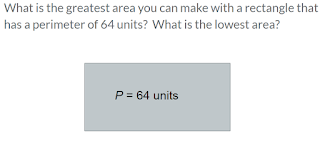At first, the students groaned and said that it was too hard, and they didn't get it. I told them to calm down and think about what the problem was asking. Once they drew it out, they started to figure it out. Here is what they came up with. I have a small class and they all came up with the same answer and agreed they used the same strategy.
I really love that they tried a solution and then checked to see if there were any other solutions that were greater. This gave them more practice solving area in just one problem. As you can see they had a picture of a square and a rectangle. They decided that the area of the square was bigger (256 sq. units). So, I drew both on the board with their areas and asked how could that be the answer if that is a square and not a rectangle. We got into a great geometry debate arguing if squares are rectangles. We decided that squares are rectangles!
For the smallest area they came up with 31 sq. units.
What was even better was that after we did this problem, one of my students made a generalization that in order to find the smallest area for any rectangle, they would have to make two of the sides equal to 1. She also decided that in order to find the greatest area they could just make a square. I wish we would have had more time to test out her theory on some other problems (hopefully we will tomorrow). I love how this problem really made them think and check if their solution was correct.




Very interesting. Thanks for sharing this. I am glad your students were able to persevere. Interestingly, depending on whether you stick to whole number side lengths, the smallest area for a rectangle is essentially zero. For example, if one side is 1/2 instead of 1, or 1/4, or one millionth, it gets infinitely smaller. Can blow some minds.
ReplyDeleteThat would be a great discussion!
DeleteI think this is super thinking...and all the thinking builds their confidence in problem solving. At what point in the unit did you give this? Beginning engage? Days into your lesson? Thank you. I love it!
ReplyDeleteI gave this one after we had done a intro lesson, but had not had too much practice.
DeleteThis comment has been removed by the author.
ReplyDelete